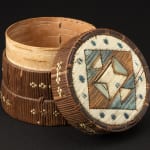-
Artworks
UNIDENTIFIED MI'KMAQ ARTIST
Quill Box, c. 1860s or somewhat laterbirchbark, natural dyed quills, 4 x 4.5 x 4.5 in (10.2 x 11.4 x 11.4 cm)
unsigned;
inscribed indistinctly in graphite in an unknown hand.
LOT 123
ESTIMATE: $1,200 — $1,800
PRICE REALIZED: $1,200.00Further images
Reaching back to the 1600s, Mi’kmaq quillwork includes a variety of techniques including stitching, plaiting, loom weaving, wrapping, and bark insertion. The 1850s saw more and more Mi’kmaq artisans using...Reaching back to the 1600s, Mi’kmaq quillwork includes a variety of techniques including stitching, plaiting, loom weaving, wrapping, and bark insertion. The 1850s saw more and more Mi’kmaq artisans using the long, thin quills from the nape of the neck to the base of the tail of the porcupine to skillfully create baskets, furniture, and decorative elements for clothes. A lidded box was still a favoured item prized by Canadians and Europeans, and the geometric and mirrored patterns woven into a birchbark top and highlighted by bolder, contrasting colours shows a change in style and practical needs; a skilled quill weaver could arrange and create the design within a day, rather than the days or weeks that something more freeform could take.
References: For numerous similar Mi’kmaq boxes see Stephen J. Augustine, Mi’kmaq & Maliseet Cultural Ancestral Material, (Gatineau: Canadian Museum of Civilization, 2005), pp. 20-120. See also Ralph T. Coe, Sacred Circles: Two Thousand Years of North American Indian Art, (Kansas City: Nelson Gallery of Art, 1977), cats 101-103. For early examples see Ralph T. Coe et al, The Responsive Eye: Ralph T. Coe and the Collecting of American Indian Art, (New York: Metropolitan Museum of Art, 2003), cats. 51,52. See also Ruth Holmes Whitehead, MicMac Quillwork: Micmac Indian Techniques of Porcupine Quill Decoration: 1600-1950, (Halifax: The Nova Scotia Museum, 1982).
Provenance
A Montreal Collection.
Join our mailing list
* denotes required fields
We will process the personal data you have supplied in accordance with our privacy policy (available on request). You can unsubscribe or change your preferences at any time by clicking the link in our emails.








